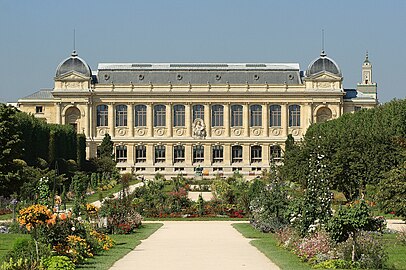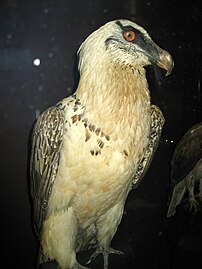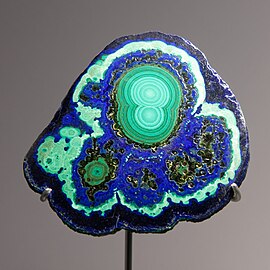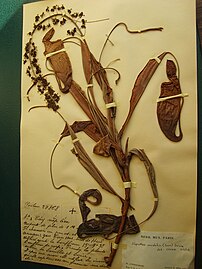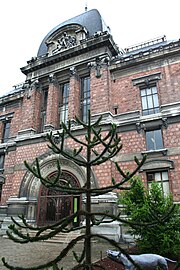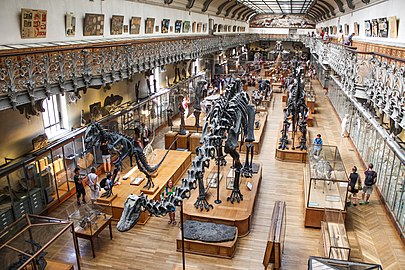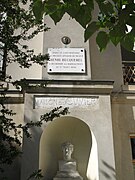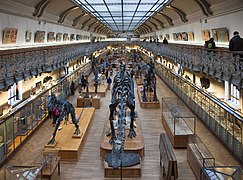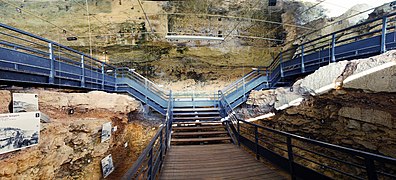National Museum of Natural History, France
Muséum national d'histoire naturelle | |
| Website | www |
|---|---|
| Muséum national d'histoire naturelle network | |
| |
The French National Museum of Natural History, known in
Since the 2014 reform, it has been headed by a chairman, assisted by deputy managing directors. The Museum has a staff of approximately 2,350 members, including six hundred researchers.[3] It is a member of the national network of naturalist collections (RECOLNAT).
History
17th–18th century
-
The Royal Garden of Medicinal Plants in 1636
-
Statue of Georges-Louis Leclerc, Comte de Buffon in the formal garden
-
Buffon's "Natural History" (1763)
-
The museum's seal, designed in 1793, illustrates the three realms of Nature, Collective work, and the French Revolution.
The museum was formally established on June 10, 1793, by the
From 1739 until 1788, the garden was under the direction of Georges-Louis Leclerc, Comte de Buffon, one of the leading naturalists of the Enlightenment. Though he did not go on scientific expeditions himself, he wrote a monumental and influential work, "Natural History", in thirty-six volumes, published between 1749 and 1788. In his books, he challenged the traditional religious ideas that nature had not changed since the creation; he suggested that the earth was seventy-five thousand years old, divided into seven periods, with man arriving in the most recent. He also helped fund much research, through the iron foundry which he owned and directed. His statue is prominently placed in front of the Gallery of Evolution.[6]
Following the
When
19th century
-
Plan of the Jardin des Plantes and its buildings in 1820
-
The photographic plate ofradioactivityof uranium (1896)
-
Crowd outside the Palace of the Apes (c. 1900) in theJardin des Plantes
The museum continued to flourish during the 19th century, particularly under the direction of
Henri Becquerel held the chair for Applied Physics at the Muséum (1892–1908). By wrapping uranium salts in photographic paper, he first demonstrated the radioactive properties of uranium. In 1903, he shared the Nobel Prize in Physics with Pierre Curie and Marie Curie for the discovery of spontaneous radioactivity.[13] Four generations of Becquerels held this chairmanship, from 1838 to 1948.[14]
As its collections grew, the museum was enlarged, with the construction of a new gallery of zoology. it was begun in 1877 and completed in 1889, for the 100th anniversary of the French Revolution. A new gallery of paleontology and comparative anatomy was opened in 1898. The cost of construction Drained the museum budget and it began to run short of funds. Its emphasis on teaching brought it into conflict with the University of Paris, which had better political connections. It gradually scaled back its program of teaching and focused primarily on research and the museum collections.[15]
20th–21st century
After receiving greater financial autonomy in 1907, it began a new phase of growth. In 1934, the museum opened the
Some of the buildings, particularly the Grand Gallery of Evolution, completed in 1889, were in poor condition by the mid-20th century. It was closed entirely in 1965, then underwent major restoration between 1991 and 1994 to its present state.[16]
Plan

Galleries and gardens
The birthplace of the museum and a large part of its modern collections are found in five galleries in the
The Grand Gallery of Evolution
-
Garden facade of the Grand Gallery of Evolution
-
Interior of the Grand Gallery of Evolution
-
Parade of African mammals
-
A stuffed bearded vulture (Gypaetus barbatus)
-
A plastified giant squid, nine meters long, in the Gallery of Evolution
The National Museum of Natural History has been called "the Louvre of the Natural Sciences".
The facade of the building was designed specifically as a backdrop for the garden. The facade facing the garden is divided into eleven traverses. Ten are decorated with sculpted medallions honouring prominent French scientists associated with the museum. The central traverse has a larger marble statue of a woman seated holding a book, in a pose similar to that of statue of Buffon facing the building. The statues are the work of
While the building exterior was neo-classical, the iron framework of the interior was extremely modern for the 19th century, like that of the Gare d'Orsay railroad station of the same period. It contained an immense rectangular hall, 55 meters long, 25 wide and 15 meters high, supported by forty slender cast-iron columns, and was originally covered with a glass roof one thousand square meters in size.The building suffered from technical problems, and was closed entirely in 1965. It was extensively remodelled between 1991 and 1994 and reopened in its present form.[20]
The great central hall, kept in its same form but enlarged during the modernisation, is devoted to the presentation of marine animals on the lower sides, and, on a platform in the center, a parade of full-size African mammals, including a rhinoceros originally presented to King Louis XV in the 18th century. On the garden side is another hall, in its original size, devoted to animals which have disappeared or are in danger of extinction.[21]
Gallery of Mineralogy and Geology
-
Gallery of Mineralogy and Geology
-
Native gold and quartz from California
-
Quartz from Uruguay
-
Fragment of the Canyon Diablo Meteorite which created Meteor Crater in Arizona
The Gallery of Mineralogy, looking across the formal garden and close to the Gallery of Evolution, was constructed between 1833 and 1837 by Charles Rohault de Fleury in a neoclassical style, with two porticos of Doric columns. Directly in front is the rose garden, renewed in 1990 with 170 types of European roses, as well as a Styphnolobium japonicum or Japanese pagoda tree, planted there by Bernard de Jussieu in 1747.[22]
The gallery contains over 600,000 stones and fossils. It is particularly known for its collection of giant crystals, including colourful examples of
The gallery also contains a large collection of
Gallery of Botany
-
The Gallery of Botany. At left is the Robinia pseudoacacia, one of the oldest two trees in Paris, planted in 1635 by Vespasien Robin
-
Slice of a giant Sequoia tree in the Gallery of Botany
-
Specimen of Nepenthes mirabilis, (tropical pitcher plant) from Southeast Asia, one of 7.5 million plants in the Herbier National
-
"Coffea guianensis", Coffee plant from Guyana, collected by Jean Baptiste Christophore Fusée Aublet in 1775
The Gallery of Botany is on the Allée the Buffon facing the centre of the garden, between the Gallery of Mineralogy and the Gallery of Paleontology. At the corner is one of the two oldest trees in Paris, a Robinia pseudoacacia or black locust, planted in 1635 by Vespasien Robin, the royal gardener and botanist, from an earlier tree brought from America by his brother, also a botanist, in 1601. It is tied in age with another from the same source planted at the same time on the square of Saint-Julien-le-Pauvre.[25]
The Gallery was built in 1930–35 with a grant from the Rockefeller Foundation. Directly in front is a statue entitled "Science and Mystery" by J.L.D. Schroeder, made in 1889. It represents the enigma of and old man meditating over an egg and a chicken, pondering which came first.[26]
The primary content of the gallery is the Herbier National, a collection representing 7.5 million plants collected since the founding of the muuseum. They are divided for study into
The ground floor interior of the gallery has vestibules built in a combination of Art Deco and Neo-Egyptian styles. It is used for temporary exhibits.[28] The exhibits include a slice of a giant Sequoia tree, 2200 years old, which fell naturally in 1917.
The Gallery of Paleontology and Comparative Anatomy
-
Facade of the Gallery of Paleontology and Comparative Anatomy
-
Relief sculpture and ironwork on the entrance of the gallery
-
Dinosaur gallery
-
Skull cast of aTyrannosaurus rex
-
Skeleton of an Aepyornis, or Elephant Bird
-
Jaw of a Cynthiacetus, an early whale, from Peru
-
Skeleton of a Southern Mammoth
The Gallery of Paleontology and Comparative Anatomy was built between 1894 and 1897 by architect
Jardin des Plantes
The
The gardens today include a large formal garden planted in geometric designs; and two enormous greenhouses, keeping tropical plants at a steady temperature of 22 degrees Celsius. The Alpine gardens present plants coming from Corsica, the Caucasus, North American and the Himalaya. The gardens of the School of Botany contain 3,800 species of plants, displayed by genre and family.[32]
Ménagerie of the Jardin des Plantes
-
The Rotunda of the Menagerie
-
Pinkflamingoesin the Menagerie
-
Enclosure forMongooses
The Menagerie is the second-oldest public zoo in the world still in operation, following the
Mission and organization
The museum has as its mission both research (fundamental and applied) and public diffusion of knowledge. It is organized into seven research and three diffusion departments.[35]
The research departments are:
- Classification and Evolution
- Regulation, Development, and Molecular Diversity
- Aquatic Environments and Populations
- Ecology and Biodiversity Management
- History of Earth
- Men, Nature, and Societies, and
- Prehistory
The diffusion departments are:
- The Galleries of the Jardin des Plantes
- Botanical Parks and Zoos, and
- The Museum of Man (Musée de l'Homme)
The museum also developed higher education, and now delivers a master's degree.[36]

Location and branches
The museum comprises fourteen sites
The
The , and other objects.
Also part of the museum are:
- Three ), the largest in France,
- Three botanical parks, the Château de Versailles, the Jardin botanique exotique de Menton and the Jardin alpin de La Jaÿsinia in Samoëns,
- Two museums, the Musée de l'abri Pataud in Les Eyzies-de-Tayac and the Harmas de Fabre in Sérignan-du-Comtat,
- Four scientific sites, the Institut de Paléontologie humaine in Paris, the Centre d'Écologie générale de Brunoy, the Station de Biologie marine et Marinarium de Concarneau and the CRESCO (Centre de Recherche et d'Enseignement sur les Systèmes Côtiers) in Dinard.
Chairs

The transformation of the Jardin from the medicinal garden of the king to a national public museum of natural history required the creation of twelve chaired positions. Over the ensuing years the number of Chairs and their subject areas evolved, some being subdivided into two positions and others removed. The
and others.In popular culture
The
The Pulitzer Prize–winning novel All the Light We Cannot See, by Anthony Doerr, partially takes place at the natural history museum; the father of the protagonist Marie-Laure works as the chief locksmith of the museum.
Directors of the museum

Directors elected for one year:
- 1793–1794: Louis Jean-Marie Daubenton
- 1794–1795: Antoine-Laurent de Jussieu
- 1795–1796: Bernard Germain Étienne de Laville-sur-Illon, comte de Lacépède
- 1796–1797: Louis Jean-Marie Daubenton
- 1797–1798: Louis Jean-Marie Daubenton
- 1798–1799: Antoine-Laurent de Jussieu
- 1799–1800: Antoine-Laurent de Jussieu
Directors elected for two years:
- 1800–1801: Antoine-François Fourcroy
- 1802–1803: René Desfontaines
- 1804–1805: Antoine-François Fourcroy
- 1806–1807: René Desfontaines
- 1808–1809: Georges Cuvier
- 1810–1811: René Desfontaines
- 1812–1813 : André Laugier
- 1814–1815 : André Thouin
- 1816–1817 : André Thouin
- 1818–1819 : André Laugier
- 1820–1821 : René Desfontaines
- 1822–1823 : Georges Cuvier
- 1824–1825 : Louis Cordier
- 1826–1827: Georges Cuvier
- 1828–1829: René Desfontaines
- 1830–1831: Georges Cuvier
- 1832–1833: Louis Cordier
- 1834–1835: Adrien de Jussieu
- 1836–1837: Michel Eugène Chevreul[39]
- 1838–1839: Louis Cordier
- 1840–1841: Michel Eugène Chevreul
- 1842–1843: Adrien de Jussieu
- 1844–1845: Michel Eugène Chevreul
- 1846–1847: Adolphe Brongniart
- 1848–1849: Adrien de Jussieu
- 1850–1851: Michel Eugène Chevreul
- 1852–1853: André Marie Constant Duméril
- 1854–1855: Michel Eugène Chevreul
- 1856–1857: Marie Jean Pierre Flourens
- 1858 to 1859: Michel Eugène Chevreul
- 1860–1861: Isidore Geoffroy Saint-Hilaire
- 1862–1863: Michel Eugène Chevreul
Directors elected for five years:
- 1863–1879: Michel Eugène Chevreul
- 1879–1891: Edmond Frémy
- 1891–1900: Alphonse Milne-Edwards
- 1900–1919: Edmond Perrier
- 1919–1931: Louis Mangin
- 1932–1936: Paul Lemoine
- 1936–1942: Louis Germain
- 1942–1949: Achille Urbain
- 1950: René Jeannel
- 1951–1965: Roger Heim
- 1966–1970: Maurice Fontaine
- 1971–1975: Yves Le Grand
- 1976–1985: Jean Dorst
- 1985–1990: Philippe Taquet
- 1994–1999: Henry de Lumley
Presidents elected for five years:
- 2002–2006: Bernard Chevassus-au-Louis
- 2006–2008: André Menez (deceased in February 2008)
- 2009–2015: Gilles Boeuf
- 2015–2023: Bruno David
- 2023–present: Gilles Bloch
Friends
The Friends of the Natural History Museum Paris is a private organization that provides financial support for the museum, its branches and the Jardin des Plantes. Membership includes free entry to all galleries of the museum and the botanical garden. The Friends have assisted the museum with many purchases for its collections over the years, as well as funds for scientific and structural development.
Pictures gallery
-
A)
-
B)
-
C)
-
D)
-
E)
-
F)
-
G)
-
H)
-
I)
-
J)
-
K)
-
L)
-
M)
-
N)
Gallery captions :
A) The cetaceum (podium of cetaceans), in the Comparative Anatomy gallery
B) Statue of
C) The alpine garden
D) The Hôtel de Magny
E) The gallery of Paleontology and Comparative Anatomy, with the statue of the First Artist by Paul Richer
F) The Gallery of Mineralogy and Geology
G) The greenhouse of New Caledonia built between 1834 and 1836 (at the time the "oriental pavilion") according to the plans of Charles Rohault de Fleury
H)
I) The Becquerel alley, north side, leads to Cuvier's house where Henri Becquerel discovered radioactivity in 1896 J) The Paleontology gallery, on the second floor, with its mezzanine. The second floor exhibits the vertebrate fossils and the mezzanine the invertebrate fossils
K) One of the zoological shelters of the menagerie
L The façade of the Musée de l'Homme, in the southwest wing of the Palais de Chaillot
M The botanical museum of La Jaÿsinia, in the Alps
N The excavations of the Pataud shelter, in Dordogne
.
See also
Notes and citations
- ^ "BILAN DU PREMIER RECOLEMENT DECENNAL DES MUSEES DE FRANCE" (PDF). mnhn.fr. 10 October 2014.
- ^ Le Figaro, January 14, 2024
- ^ "Organigramme & rapports d'activité". Muséum national d'Histoire naturelle (in French). Archived from the original on 2023-02-06. Retrieved 2023-06-21.
- ^ Deligeorges, Gady and Labalette, "Le Jardin des Plantes et le Muséum national de'histoire naturalle" (2004, p.14
- ^ Deligeorges, Gady and Labalette, "Le Jardin des Plantes et le Muséum national de'histoire naturelle" (2004), pp. 4–5
- ^ Deligeorges, Gady and Labalette, "Le Jardin des Plantes et le Muséum national de'histoire naturelle" (2004), p. 10
- ^ Deligeorges, Gady and Labalette, "Le Jardin des Plantes et le Muséum national de'histoire naturelle" (2004), p. 9
- ^ Deligeorges, Gady and Labalette, "Le Jardin des Plantes et le Muséum national de'histoire naturelle" (2004), p. 15
- ^ Chevreul, M.E., Recherches sur les corps gras d'origine animale, F.G. Levrault, Paris, 1823
- ^ Chevreul, M.E. Note sur le Sucre de Diabetes, Annales de Chemie, Paris 1815
- ^ "An Introduction to Creatine". 2016-11-23. Archived from the original on 2021-08-15. Retrieved 2021-08-15.
- ^ Itten, Johannes, The Art of Color, New York, 1961
- ^ Henri Becquerel – Biographical Archived 2017-12-19 at the Wayback Machine Nobelprize.org.
- from the original on August 28, 2007. Retrieved March 20, 2007.
- ^ Deligeorges, Gady and Labalette, "Le Jardin des Plantes et le Muséum national de'histoire naturelle" (2004), pp. 20–22
- ^ Deligeorges, Gady and Labalette, "Le Jardin des Plantes et le Muséum national de'histoire naturelle" (2004), pp. 20–22
- ^ Deligeorges, Gady, Labalette, "Le Jardin des Plantes et le Museum National d'Histoire Naturelle" (2004), p. 38
- ^ Deligeorges, Gady, Labalette, "Le Jardin des Plantes et le Museum National d'Histoire Naturelle" (2004), p. 38
- ^ Deligeorges, Gady, Labalette, "Le Jardin des Plantes et le Museum National d'Histoire Naturelle" (2004), p. 38
- ^ Deligeorges, Gady, Labalette, "Le Jardin des Plantes et le Museum National d'Histoire Naturelle" (2004), p. 39
- ^ Deligeorges, Gady, Labalette, "Le Jardin des Plantes et le Museum National d'Histoire Naturelle" (2004), pp. 40–41
- ^ Deligeorges, Gady, Labalette, "Le Jardin des Plantes et le Museum National d'Histoire Naturelle" (2004), p. 42
- ^ Deligeorges, Gady, Labalette, "Le Jardin des Plantes et le Museum National d'Histoire Naturelle" (2004), pp. 42–43
- ^ [1] Archived 2021-08-23 at the Wayback Machine site of the Jardin des Plantes- Gallery of Geology and Mineralogy
- ^ Deligeorges, Gady, Labalette, "Le Jardin des Plantes et le Museum National d'Histoire Naturelle" (2004), p. 42
- ^ Deligeorges, Gady and Labalette (2004), p. 44
- ^ Mori, Scott A. "Jean Baptiste Christophe Fusée Aublet (1720–1778)". NYBG. New York Botanic Garden. Archived from the original on 2021-10-10. Retrieved 2021-08-25.
- ^ Deligeorges, Gady and Labalette (2004), p. 44
- ^ Deligeorges, Gady and Labalette (2004), p. 45
- ^ Deligeorges, Gady and Labalette (2004), pp. 4–5
- ^ Deligeorges, Gady and Labalette (2004), pp. 28–29
- ^ Deligeorges, Gady and Labalette (2004), pp. 28–29
- ^ [2] Archived 2021-08-07 at the Wayback Machine Site of the Jardin des Plantes (in English)
- ^ Deligeorges, Gady, Labalette, "Le Jardin des Plantes et le Museum National d'Histoire Naturelle" (2004), p. 58
- ^ "Muséum national d'histoire naturelle; official website". Archived from the original on 2008-02-26. Retrieved 2008-02-16.
- ^ "Official website". Archived from the original on 2010-08-30. Retrieved 2010-12-12.
- ^ "Implantations, site of the MNHN". Archived from the original on 2012-07-09. Retrieved 2012-05-25.
- ^ Holmgren, P. K.; N. H. Holmgren. (2008). "Muséum National d'Histoire Naturelle". Index Herbariorum. The New York Botanical Garden. Archived from the original on 2023-07-18. Retrieved 2009-03-10.
- ^ Night at.
{{cite journal}}: Missing or empty|title=(help)
Bibliography (in French)
- Deligeorges, Stephane; Gady, Alexandre; Labalette, Françoise (2004). Le Jardin des plantes et le Muséum national d'histoire naturelle (in French). Éditions du Patrimoine- Centre des Monuments Nationaux. ISBN 978-2-85822-601-6.
External links
- MNHN official website (English version)
- the Virtual Gallery of Mineralogy (English version)
- Flickr Mostly Paris, some Lille.
- Photos of Muséum national d'histoire naturelle (English version)








